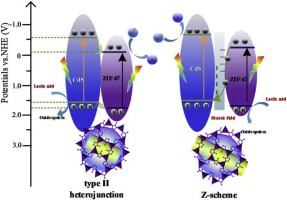Molecular Catalysis ( IF 4.6 ) Pub Date : 2020-02-17 , DOI: 10.1016/j.mcat.2020.110797 Zebin Yu , Lun Qian , Tao Zhong , Qi Ran , Jun Huang , Yanping Hou , Fengyuan Li , Mingjie Li , Qianqian Sun , Heqing Zhang

|
Enhanced light absorption, improved separation of photoelectrons and holes, and controllable electron transfer paths are important ways to improve photocatalyst performance. In this work, a convenient but more efficient method is adopted to prepare composite photocatalysts integrating narrow gap semiconductors and zeolitic imidazolate frameworks (ZIFs). We chose ZIF-67, a typical ZIF, as the model and integrate it with CdS to self-assemble into highly crystalline [email protected] composites. Extensive characterization methods (e.g., XRD, FE-SEM, UV–vis DRS, Raman, XPS, HRTEM, TEM, M–S, EIS and FT-IR) were applied to understand the correlations between performance and interface structure and morphology of the composite catalysts. Results demonstrate that the performances of the composite catalysts were greatly improved. [email protected] with optimized particle size (200 nm), limited shell thickness (less than 100 nm) and the shape of sugar gourd strings with Z-scheme interface structures was the best. Its H2 evolution rate and degradation rate constant of methylene blue (MB) under visible light irradiation were up to 6.7 and 3.1 times over those of bare CdS nanorods, respectively. Possible mechanisms of structure-morphology-performance were proposed. Optimizing the size and shape of composites can be used to regulate the morphology and interface structures of the composite catalysts to enhance their visible light photocatalytic activities.
中文翻译:

通过与ZIF-67可控的自组装复合增强CdS的可见光光催化活性
增强的光吸收,改善的光电子和空穴的分离以及可控的电子传输路径是提高光催化剂性能的重要方法。在这项工作中,采用方便但更有效的方法来制备集成了窄间隙半导体和沸石咪唑酸酯骨架(ZIF)的复合光催化剂。我们选择了典型的ZIF ZIF-67作为模型,并将其与CdS集成在一起以自组装为高度结晶的[受电子邮件保护的]复合材料。广泛的表征方法(例如,XRD,FE-SEM,UV-vis DRS,拉曼,XPS,HRTEM,TEM,MS,EIS和FT-IR)被用于理解性能,界面结构和形态的相关性。复合催化剂。结果表明,复合催化剂的性能大大提高。具有最佳粒径(200 nm),有限的壳厚度(小于100 nm)以及具有Z方案界面结构的糖葫芦丝的形状[受电子邮件保护]是最好的。其H在可见光照射下,亚甲基蓝(MB)的2演化速率和降解速率常数分别是裸CdS纳米棒的6.7和3.1倍。提出了结构-形态-性能的可能机制。优化复合材料的尺寸和形状可用于调节复合催化剂的形态和界面结构,以增强其可见光光催化活性。


























 京公网安备 11010802027423号
京公网安备 11010802027423号